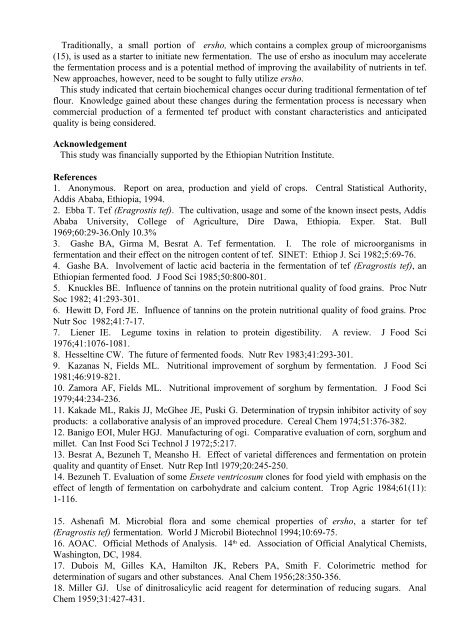Original article - Ethiopian Review
Original article - Ethiopian Review
Original article - Ethiopian Review
- No tags were found...
Create successful ePaper yourself
Turn your PDF publications into a flip-book with our unique Google optimized e-Paper software.
Traditionally, a small portion of ersho, which contains a complex group of microorganisms(15), is used as a starter to initiate new fermentation. The use of ersho as inoculum may acceleratethe fermentation process and is a potential method of improving the availability of nutrients in tef.New approaches, however, need to be sought to fully utilize ersho.This study indicated that certain biochemical changes occur during traditional fermentation of tefflour. Knowledge gained about these changes during the fermentation process is necessary whencommercial production of a fermented tef product with constant characteristics and anticipatedquality is being considered.AcknowledgementThis study was financially supported by the <strong>Ethiopian</strong> Nutrition Institute.References1. Anonymous. Report on area, production and yield of crops. Central Statistical Authority,Addis Ababa, Ethiopia, 1994.2. Ebba T. Tef (Eragrostis tef). The cultivation, usage and some of the known insect pests, AddisAbaba University, College of Agriculture, Dire Dawa, Ethiopia. Exper. Stat. Bull1969;60:29-36.Only 10.3%3. Gashe BA, Girma M, Besrat A. Tef fermentation. I. The role of microorganisms infermentation and their effect on the nitrogen content of tef. SINET: Ethiop J. Sci 1982;5:69-76.4. Gashe BA. Involvement of lactic acid bacteria in the fermentation of tef (Eragrostis tef), an<strong>Ethiopian</strong> fermented food. J Food Sci 1985;50:800-801.5. Knuckles BE. Influence of tannins on the protein nutritional quality of food grains. Proc NutrSoc 1982; 41:293-301.6. Hewitt D, Ford JE. Influence of tannins on the protein nutritional quality of food grains. ProcNutr Soc 1982;41:7-17.7. Liener IE. Legume toxins in relation to protein digestibility. A review. J Food Sci1976;41:1076-1081.8. Hesseltine CW. The future of fermented foods. Nutr Rev 1983;41:293-301.9. Kazanas N, Fields ML. Nutritional improvement of sorghum by fermentation. J Food Sci1981;46:919-821.10. Zamora AF, Fields ML. Nutritional improvement of sorghum by fermentation. J Food Sci1979;44:234-236.11. Kakade ML, Rakis JJ, McGhee JE, Puski G. Determination of trypsin inhibitor activity of soyproducts: a collaborative analysis of an improved procedure. Cereal Chem 1974;51:376-382.12. Banigo EOI, Muler HGJ. Manufacturing of ogi. Comparative evaluation of corn, sorghum andmillet. Can Inst Food Sci Technol J 1972;5:217.13. Besrat A, Bezuneh T, Meansho H. Effect of varietal differences and fermentation on proteinquality and quantity of Enset. Nutr Rep Intl 1979;20:245-250.14. Bezuneh T. Evaluation of some Ensete ventricosum clones for food yield with emphasis on theeffect of length of fermentation on carbohydrate and calcium content. Trop Agric 1984;61(11):1-116.15. Ashenafi M. Microbial flora and some chemical properties of ersho, a starter for tef(Eragrostis tef) fermentation. World J Microbil Biotechnol 1994;10:69-75.16. AOAC. Official Methods of Analysis. 14 th ed. Association of Official Analytical Chemists,Washington, DC, 1984.17. Dubois M, Gilles KA, Hamilton JK, Rebers PA, Smith F. Colorimetric method fordetermination of sugars and other substances. Anal Chem 1956;28:350-356.18. Miller GJ. Use of dinitrosalicylic acid reagent for determination of reducing sugars. AnalChem 1959;31:427-431.




![to read the full report [pdf, Amharic] - Ethiopian Review](https://img.yumpu.com/52737829/1/190x245/to-read-the-full-report-pdf-amharic-ethiopian-review.jpg?quality=85)











